#Copy and paste values in excel
Explore tagged Tumblr posts
Text
Transformando sua eficácia de copy com automação e IA
Neste artigo, exploraremos como as ferramentas de automação e inteligência artificial podem revolucionar a criação e gestão de conteúdo, facilitando tarefas como copiar automaticamente, salvar screenshots no clipboard do Mac, e aplicar fórmulas ao inserir linhas em planilhas. Descubra como essas tecnológias podem aumentar sua produtividade e eficiência na sua estratégia de marketing…
#Auto Copy#Automate outlook calendar#Clipboard mac#Copy and paste values in excel#Copy cells in excel#Copy hours#Example copy-dbadbtabledata#Excel automation#File transfer automation#Formula automation
0 notes
Text
so i'm preparing a data collection sheet in excel and i need the participants' ages
so i've been looking up their DOBs in our CRM & then tediously entering it into a calculator to get the age and then typing it into excel
when i literally just now realized, wait, i'm using excel, i can just type the formula in the cell and have it put the age for me
sigh
#chocolate life#also i got to learn how to concatenate cells today so that was fun#and the other day i learned how to copy & paste the values from a formula so you can get rid of the reference columns#maybe one day i'll actually be competent at excel lmao
3 notes
·
View notes
Text
I made a video explaining the very basics on how sprite comics are made! I opted to choose Microsoft Paint because it's a simple program that's easily available on Windows.
If you use macOS, the closest fit would be Paint X, available for like $10. Of course, if you're going to pay for a pixel art tool, Aseprite is much better, and that program has an excellent manual. You could also start an Adobe Creative Cloud subscription to get PhotoShop (or set sail and download a previous version from a fun place).
Free tools are available, like GIMP (because I'm old), Pixelorama, Krita, Paint.net, the list goes on.
Fonts I recommended:
Back Issues
Atkinson Hyperlegible
Transcript below the readmore!
Sprite comics are easy. You just need sprites and an image editing program.
Most comics in the BZPower days were made in MS Paint and they were not fancy-looking comics like mine. Most of them looked like this, and it works very well! In MS Paint, you only need to know two tricks:
The eraser tool has a right-click function that only replaces Color 1 with Color 2. This will help you recolor your sprites.
You can copy and paste sprites as transparent images. Click the dropdown under the selection tool and select "transparent selection" to filter out Color 2.
Here's some bonus advice:
People have huge resolution monitors now, so I recommend doubling your comic's size. In MS Paint, select Resize and then type 200 in the percent field.
The most common mistake is unreadable text. Always pick a font that is easy to read and simple. Opt for a "sans serif" font as they're easier to read than "serif" fonts. Here are two good default pixel fonts:
Small Fonts, size 20
System, size 24
If you don't want to use a pixel font, then you can use Arial or Comic Sans. There are tens of thousands of downloadable fonts, too.
For non-pixel fonts, I'm partial to Atkinson Hyperlegible by the Braille Institute. I also like having a comic book feel to my comics, so I use "Back Issues" by Blambot.
Be sure to pick colors that are easy on the eyes. Like, we can agree that this is kinda harsh. These colors are more gentle. Using gentle colors also makes your more colorful characters pop out.
If you're doing colored text on colored backgrounds, you want a high degree of contrast. Notice that when I apply this Chroma filter, you can see why the text is unpleasant to read; the lightness values shown here are way too close. I can make the background darker and the font brighter to help that.
You should also try to have a system when doing dialogue. People will read top to bottom, left to right. It makes sense for dialog to follow that pattern. If you're going to use lines to indicate who's talking, try to avoid making the lines cross. Plan your dialogue, rearrange the characters if you need to, etc etc.
If you're pressuring yourself and not having fun, then you're ruining it. You don't need translucent word balloons, you don't need fancy custom background art, you don't need to be super witty, and you don't need to obey this video! Just have fun. And send me your Bionicle sprite comics.
14 notes
·
View notes
Text
Paul Tully recalls an interview about Stallone in which he addressed turning down a considerable quantity of money for the Rocky role because he aimed to become an actor and portray the role himself. Despite an extensive offer of $300,000 in 1976, Stallone remained determined to pursue his passion despite having just $400. Daniel understands Stallone's choice since he had to choose between financial comfort and pursuing his passions. Paul finds Stallone's interview incredibly inspirational since he has faced comparable challenges and sacrifices in his search for happiness.
When reflecting on Stallone's path, Paul admits to being familiar with having to live on little and make sacrifices to pursue one's ambition. He understands the appeal of staying with what one knows, even if it means facing financial difficulties. Stallone's commitment to pursuing his aspirations against the odds acts as an inspiration for Paul, who understands the value of remaining true to oneself and seeking what offers genuine satisfaction, even if it means confronting uncertainties and hardships along the way.
Paul finds parallels between Stallone's situation and his own, in which he had to choose between returning to a toxic environment for more salary or continuing to follow his passion despite lesser compensation. He admits the desire to pursue financial security but eventually chooses to devote his whole attention to his love, as Stallone did with acting. Paul highlights the necessity of remaining committed to one's objectives and not succumbing to societal expectations or financial worries, as success may be achieved by following one's heart and giving it one's best, which he finds tremendously motivating.
Paul takes comfort in Stallone's interview, recognizing that success frequently entails taking chances and making sacrifices. He urges people not to worry about their decisions and to believe in their ability to overcome hurdles to reach their goals. Paul’s path serves as a reminder that achieving pleasure and satisfaction is worth the uncertainty and hardships that may emerge along the route, and it is an excellent source of motivation.
WATCH the related video: 7-FIGURE DOG WALKING BUSINESS | DANIEL MARTIN’S INSPIRING STORY FROM BEING HOMELESS TO CEO
Please take note that the links below are NOT clickable anymore. You can copy and paste them into your browser.
40 notes
·
View notes
Text
My Favorite Cards from 2024: Foundations
The year is pretty close to over, so let’s go back over the sets released this year (with new cards at least), and go through a few of my favorite cards from that release. I’ll group together stuff released together, in this case it’ll be the main Foundations set and the Foundations Jumpstart cards. Particularly welcome reprints might also get a mention.

I've been having a lot of fun with Raise the Past, and it's an excellent example of what new Foundations cards should be: a card that's simple, yet still powerful and at a rate we haven't really seen before. In the wake of Rally the Ancestors and Return to the Ranks. A mass of small creatures is a very white way to use the graveyard, and very fun.

A very splashy 3-drop, if you'll pardon the pun, Kiora has made an impact in quite a few decks. The base rate of a 3/2 that loots twice on etb isn't bad, but then the opponent has to deal with it anyway even if you've already gotten your value, because they can't just let you have a free 8/8 from your three drop. The looting helps to get to Threshold, wrapping the entire card into a nice package.
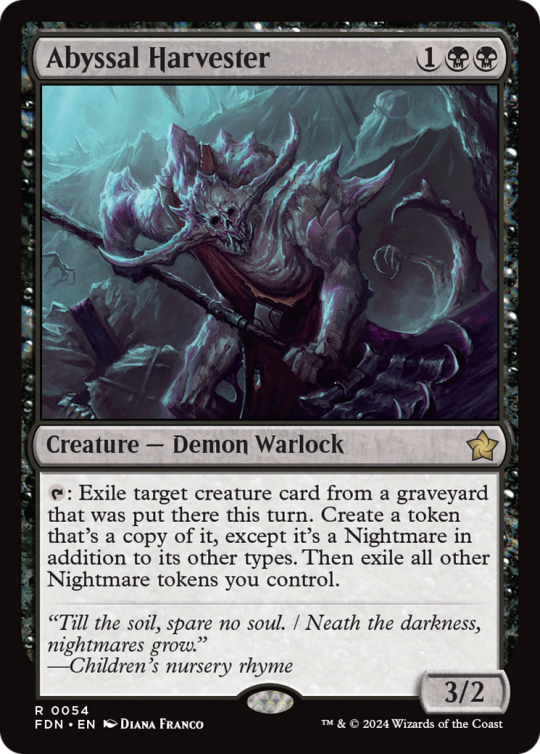
Doubling minor graveyard hate with fun copying and stealing effects is a good way to my heart. Abyssal Harvester does that, sadly it's held back by its fragile body on a creature that doesn't do anything until you untap with it. Still, I like the design!

Look at the kitty! It's like the cute dog but not an enchantment! I also love the cute dog, and I love cantripping bodies in the color that can best use them! A cat that'll make its way into plenty of my decks.

A lot of graveyard stuff in this list, but we don't see those kinds of rewards too often in blue, and a card every time is really good. Neerdiv does her best River Kelpie impression for half the cost and available in the command zone, and then she even enables herself!
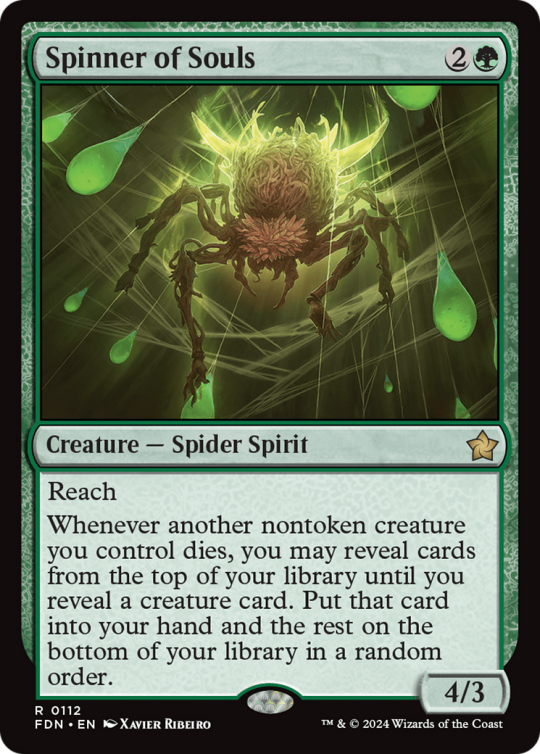
I do not know why green got this card, but Spinner of Souls sure exists and is good! Not every green creature deck will reliably have creatures dying enough to make it worth the inclusion, but considering that Fecundity sees a decent amount of commander play, and Foster should see a bit more, there are definitely homes there. I do love an Evolutionary Leap. All of that on a body big enough it gets a chance in competitive formats? I'll take it!

Efficient engines that can both attack and draw cards at 2 mana are a really nice place to be in mono-white. Brigone is niche enough to get the counters with her own effect that she's not oppressive, and adds a nice tension between keeping her able to smack people with a lot of counters and getting cards to trigger her. Using her in other counter decks that don't rely on her Heroic effect is also possible, and makes her not just confined to those very few decks.
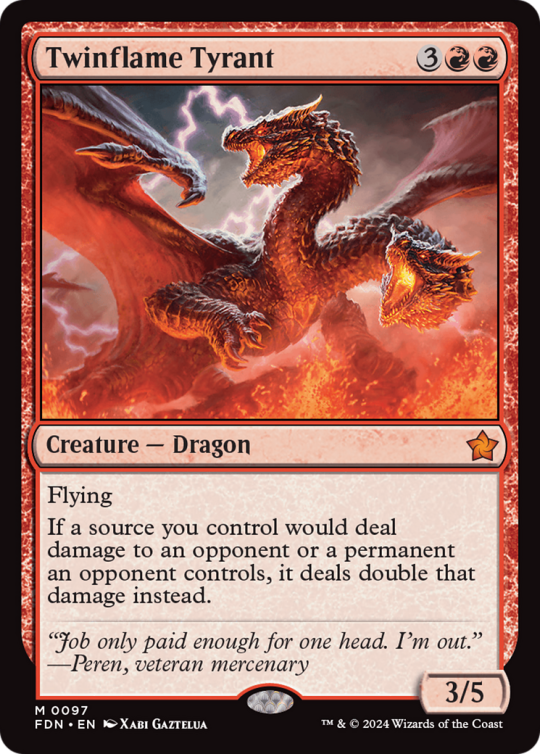
Twinflame Tyrant is the big mythic dragon for Foundations, and it passes the muster! Not oppressive without haste by itself, it pushes up an effect two mana from when we last saw it this widely on a body with Angrath's Marauders. It's simple, which is a plus, and impressive and gets people excited! Also an art that looks great in foil.
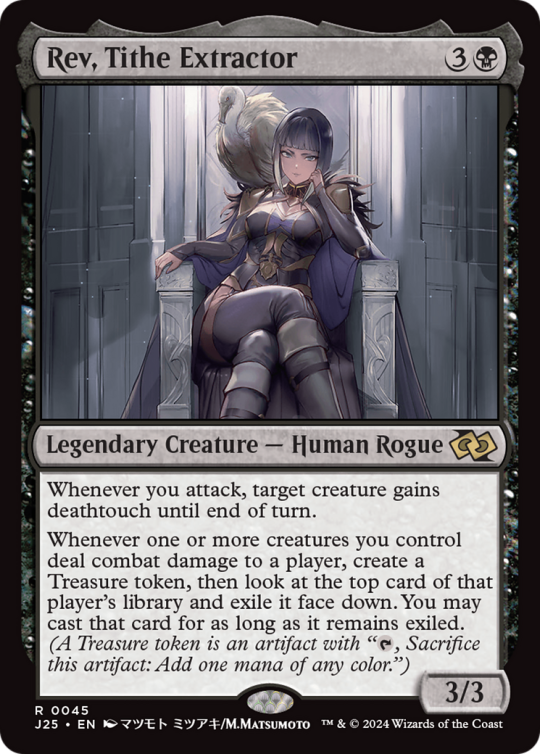
Sadly, I'm not the only one that likes Rev's design, and as a result she's currently at an unreasonable price. Moving past that, getting mana and cards out of every attack is very much something that's worth the four mana, and I do love stealing other people's cards. Being able to get up to three cards and treasures per turn in commander by attacking multiple opponents seals the deal on the design for me... If I can ever get some copies for a price I'd pay for a card in a commander deck.
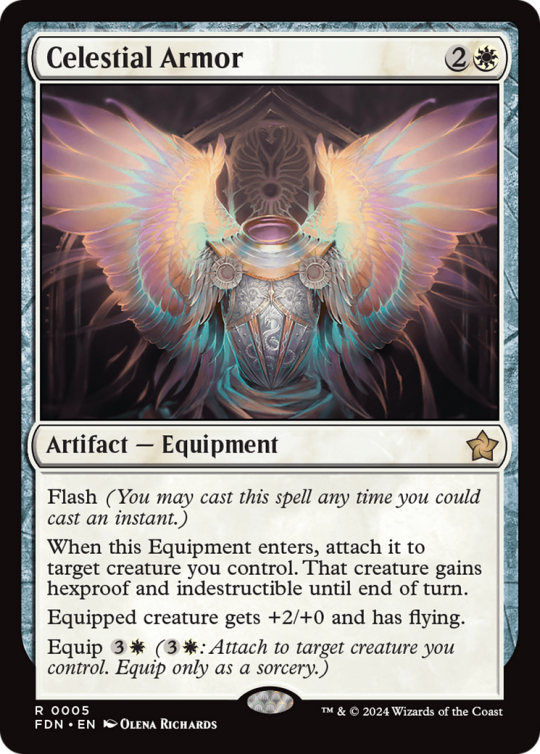
I like Celestial Armor more than Maul of the Skyclaves, which it compares to. Targeted protection spells are generally too situational to warrant a slot in decks, so one that pulls its own weight by also being a decently threatening equipment in decks that would want that allow this one to be played. This in turn makes the game more interactive, because now players have to play around the possibility of the opponent running some protection spell. Everybody wins! Except the player who's removal spell just got fizzled.
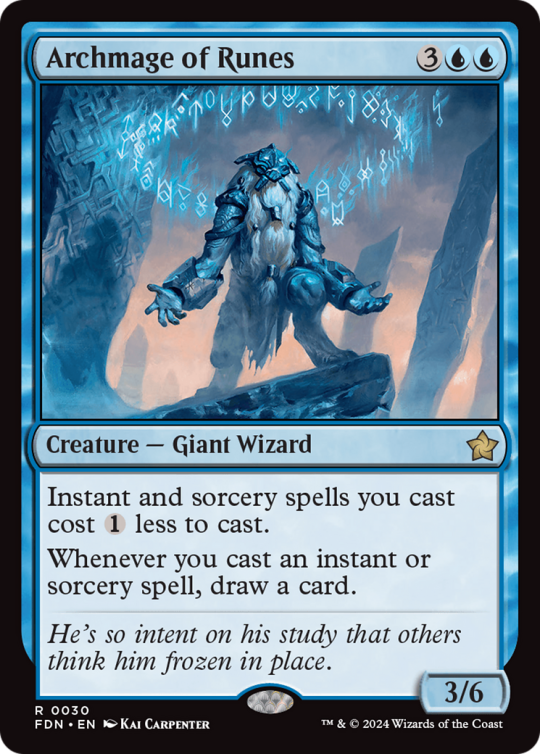
Again, Archmage of Runes is simple, clean and effective. Combining two popular effects into one, not prohibitively expensive card, repaying the one mana more you spend on this compared to an Archmage Emeritus by the time you cast your first discounted spell.

A new Alesha! Who wouldn't love old lady Alesha, still turning sideways and still bringing back creatures to fight. Getting some potential immediate value compensates well the loss of some of the tricks of the original Alesha, but it's still a card I love being in the foundational set of magic.
Reprints:

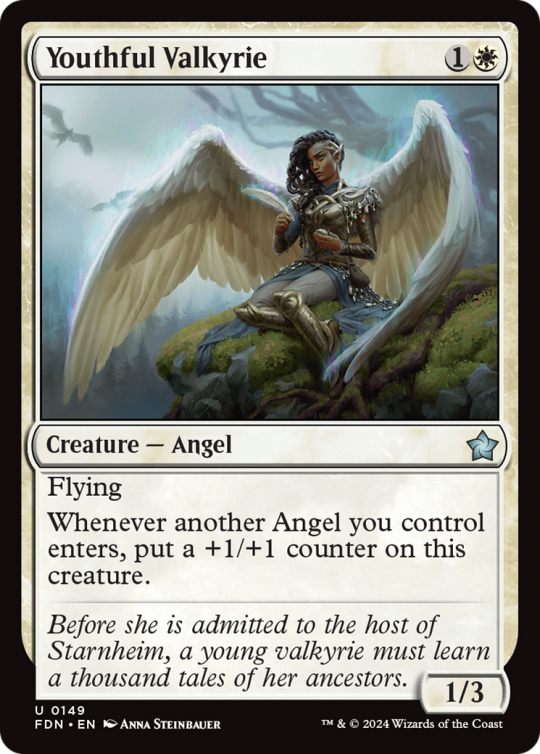
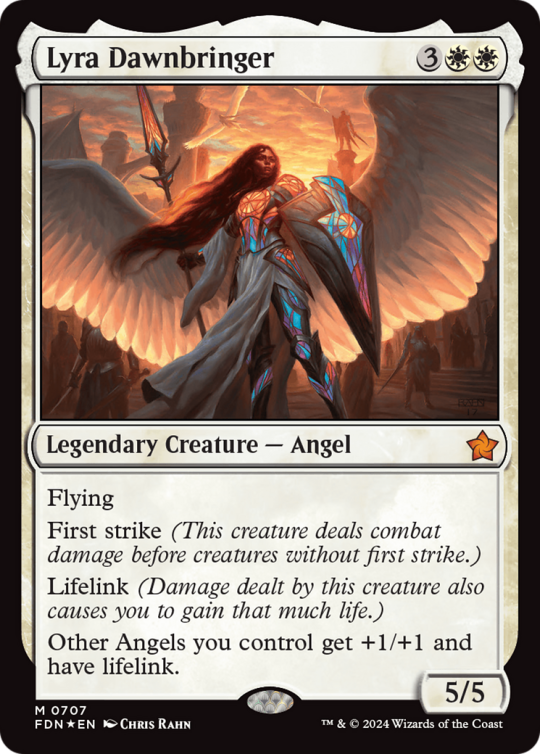
Seeing this angel package return in Foundations is a welcome sight. Plenty of players love angels and that's a great entry point. Plus Youthful Valkyrie gets an ACTUAL printing this time which should help greatly with supply.



The vegetables package! Duress and Negate kinda HAD to be in the set, it avoids them having to reprint it in a standard set every couple years. Burst Lightning is a welcome surprise in this package of efficient base spells for standard.
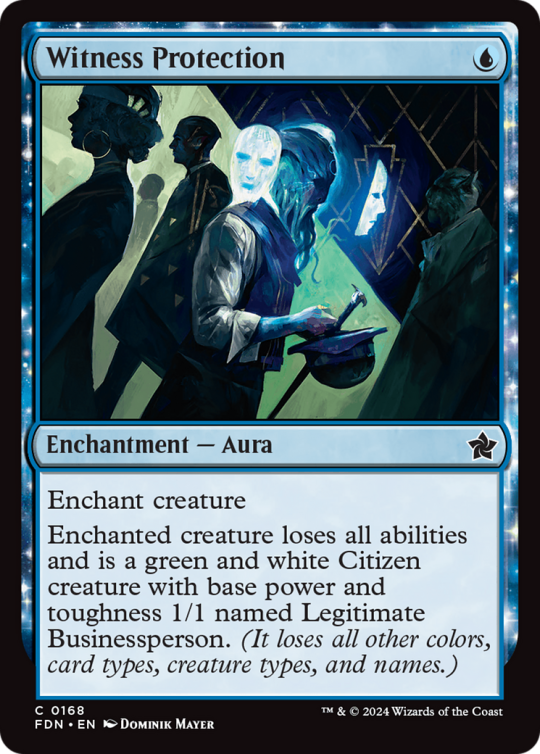
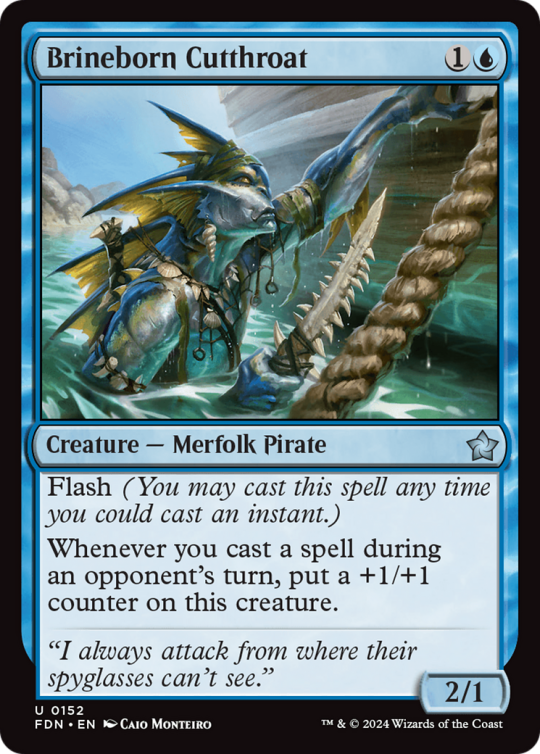
In blue, we got the return of Witness Protection, which still holds some of the best trinket text in the game, beautifully tying together the design. Just for the sake of that, it deserves a place here. Brineborn Cutthroat is just a solid way for a flash deck to actually finish the game, and plays into the aspects of blue that appeals to many players (and gets it hated by many other players.)
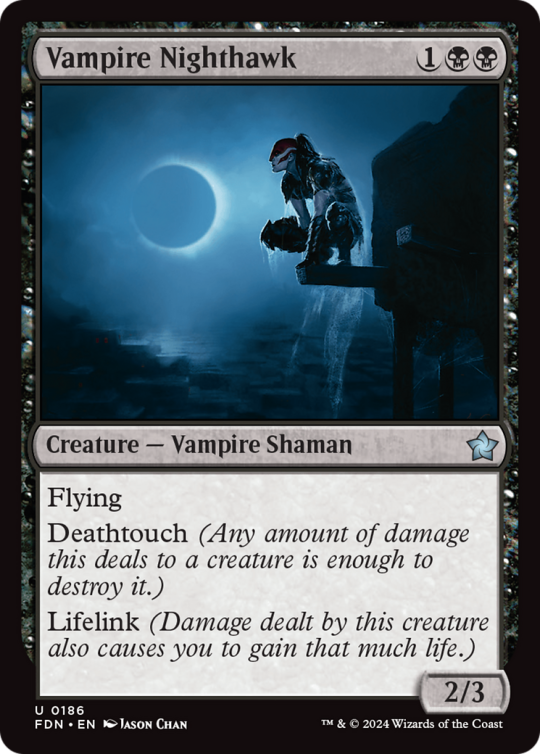
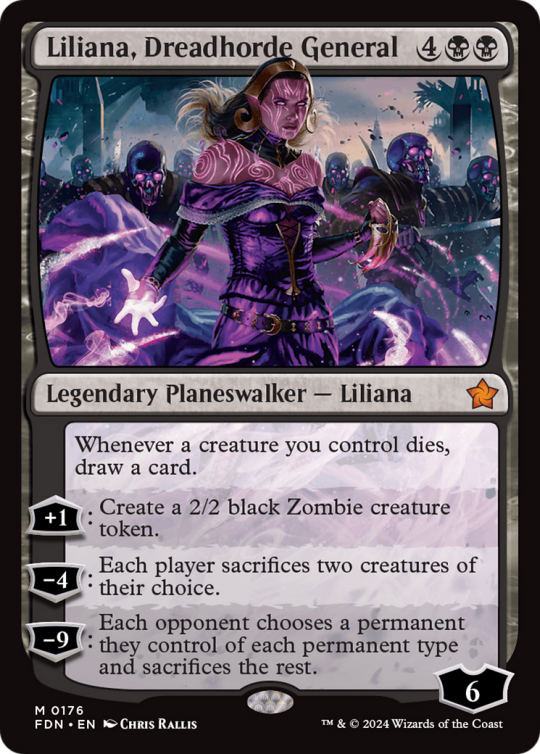
Vampire Nighthawk more than any other card in Foundations sent a pang of nostalgia through me, and I wasn't even actively playing last time around!
Liliana, Dreadhorde General is a great card that sees play in plenty of commander decks and has seen play in standard, and seeing another reprint to keep the price low is very encouraging!

Scooze is back! I love Scooze! As long as it's not exiling my perfectly fair graveyard strategy, of course. Anyway, it's very funny that Scavenging Ooze started as a card from a commander precon and went on to become a "Foundational part" of Standard.
13 notes
·
View notes
Text
As Time Goes On
Juno Collection Masterpost
Original Piece by Chai
Next
Companion Piece by Chai (lunch scene)
Second Companion Piece by Chai (medical scene)
Warnings: slavery, mentions of death, mentions of illness, mentions of torture
Context: A reverse AU of King's Counsel
Emperor Jason the fifth, known as King Jason in public, lay in bed staring up at the ceiling.
It was just before dawn, and he valued the time to meditate before the day truly began.
The past eight years had been hard on him. Measles had swept through the nation and taken all but two of his family members. And then his nephew had disappeared.
Jason had searched and searched, and then mourned him to be dead. Mourned that the only ones left were himself and his beloved daughter Jackal III.
But nearly six years after sealing an empty coffin in the family crypt, he was discovered alive.
Enslaved, in plain sight.
Lord Aspen was sentenced to torture, but it wasn’t enough. Nothing would be enough. To satisfy his need for justice, for resolution, for satisfaction.
The cold monthly reports of Aspen’s treatments didn’t change anything. Even potentially doing them himself wouldn’t help anyone. And the last thing his nephew needed was finding out his uncle’s capacity for violence.
Jason wasn’t sure he would ever forgive himself.
Every day was a cycle of despairing grief and overwhelming joy. Joy that he was home, alive, safe, and grief that he was gone.
The nephew who excelled in math classes despite hating them, who swam and loved childrens’ novels at fifteen, who was a great shot with a crossbow and clumsy with a sword, who laughed and smiled freely, was gone. He’d been replaced with a copy. A copy who never stopped trembling, who was gaunt and scared and quiet. Who Jason had to coax to eat, and then hardly did anyway.
He would never get his nephew back. Not truly.
But today was another day, and Jason would thank the gods endlessly for what he had. A living daughter and a nephew back from the dead.
Jason got up, throwing open the curtains to let the first golden rays of the rising sun into his rooms. He breathed in the morning air.
Another day. A new day.
He was alive, and that was a gift.
___________________
Achilles was a friend, one he’d known for years. Their wives were distant cousins, and Jason had been thrilled for them when Ophelia and Achilles announced they were expecting twins.
Jason had sent them gifts for the baby shower, and had prepared two more for the day the twins entered the world.
Those presents would never be sent now.
The letter Achilles had sent a week ago was a pleasant surprise.
He had no use for the slave he’d bought for Ophelia and the boys, and Jason was touched that Achilles was thinking of Jason’s family even in his grief.
So of course he accepted.
___________________
Achilles looked grim, still deep in the throws of mourning. But it could be much, much worse.
Jason hadn’t buried his own children. Achilles had.
All things considered, his friend was doing well.
“Your Majesty,” he greeted, voice dull. The slave knelt on the rug, head bowed.
���Achilles.” Jason put down his paperwork. “How are you?”
“The same,” he said stiffly. “One day at a time.”
“Of course. Would you like to stay for a few days? You’ve had a long journey, and we haven’t seen each other-” since the baby shower- “in so long.”
Achilles’s shoulders slumped. “It would be nice to be away from the estate for a while,” he admitted. “Thank you.”
“If you need anything, anything at all, you need only ask,” Jason said gently.
Achilles nodded. “I know. But enough about me, how are you doing?”
Jason’s eyes wandered to the slave. “One day at a time.”
“Right.”
“What do you call him, again?” He nodded to the slave.
“Thallos. He’s gentle; a calm personality. Ophelia likes- liked him.”
Jason studied Thallos. He was handsome, with wavy dark hair and good features. In his thirties. His skin had seen some sun, and looked healthy enough.
Achilles was an honorable man, and Jason didn’t doubt that he treated his slaves well. He would do a more thorough inspection with a healer later.
Jason tilted the slave’s face up. His eyes were an unusual shade of brown, but striking. He had a few beauty marks, and some old scars down his neck. Jason was in no place to judge; he had some facial scars himself.
The slave’s face was blank and unemotive, which Jason recognized as a slave’s typical nervousness.
“A fine gift you are,” he assured the man. He looked back up at Achilles.
“Let’s have lunch,” he suggested. “The three of us. You must be famished, and I’d like to know Thallos more before introducing him. As a precaution.”
“I’d like that.”
taglist: @haro-whumps @paintedpigeon1 @phoenixpromptsandstuff @tianablackwell @starsick1979
#reverse au :3#chai is calling it#Prince's Solace#its a good name so im gonna call it that too#whump#my writing#slavery whump
9 notes
·
View notes
Note
Holy shit that post where you mentioned the Avalon book series!!! I read those books growing up!! I ADORED them!! I think I still have them actually. I have the second editions – I didn’t even know they weren’t the original editions till now. I can’t imagine them without the pretty covers and illustrations tbh. The art is part of why I loved the series so much! And I’d never thought about it as a Western magical girl series but you’re kinda right! That’s such a cool way of looking at it. Anyways, thanks for the blast from the past :3
Ace, I'm happy to hear from you, and I'm ecstatic to hear you also have and love the Avalon books!
The genealogy of the series has always struck me as sort of epic because of the way it was born from Jewel Riders (and indirectly, Pern, which I also love)! There are several aspects of Jewel Riders that made it into Avalon, but Avalon also really became its own thing and it's genuinely fantastic. Also surprisingly dark at times and very well-written.
The reason I know the newer editions aren't the OG is because I originally read this bind-up of the first three books at some point in early high school?

All the original first editions sport these kind of photoshopped semi-realistic images of the three same models, with varying degrees of Lisa Frank color vibrancy as their covers. Some are slightly better than others. This is one of the less better ones imo.

I found the later editions I think in my last year of high school. Those had the more anime magical girl-esque covers, with the included illustrations and the compendium entries of the magical animals. I also realized very quickly that some of the slang and language was updated to be more modern (the notable one that always sticks out in my mind was when Ozy goes crowd surfing, the OG editions have him saying a quick "WOOHOO!" whereas the newer editions have him yelling a drawn-out "W00t!" and that change always makes me laugh) but more importantly, the older editions use a lot of harmful and tone-deaf references and terms for Adrian that the newer ones removed. I believe there was also a change or two added to some of Kara's insults that she slings around in the first several books, so she could still be clearly interpreted as a jerk early on without seeming like an irredeemable little snobby bigot, but I may need someone else with copies of the older editions to fact-check me on that one.
But yeah I also MUCH prefer the newer editions, for the art, the illustrations and all the extras put into them! Even if I'm not the target demographic anymore, those books have a very special place in my heart, and they do really have excellent nostalgia value!
6 notes
·
View notes
Text
Gavii Learns Stuff - Colorwork and also FFXIV
I don't know colorwork, so naturally I'm making G'raha Tia's Endwalker scarf. Oh, and I'm also primarily a crocheter, so let's plan to knit it instead.
I have no self control when inspiration strikes, and also I like to learn by doing, so here we are - this'll be my journey.
Step 1: Screenshot the hell out of Raha
Can we talk a moment about how strange this scarf design is? Not the colorwork, but the actual structure of this strange piece of material.

The main center design drapes down from his right shoulder to his left, then down the front, but then the opposite length somehow wraps, then pivots to turn right back down the same shoulder. There's gotta be a button or something, and even with the twine or rope that's clearly keeping everything together, I can't figure out the full construction of this one. If inspo strikes along the way we'll see, but for now I think I plan to just make a full scarf, and worst case, it can be knotted on the the left shoulder to create the effect where the two length drape down the same side in the front and back.
We can make it work. But, darling, your scarf makes no sense.
Step 2: Study the design, draft, re-draft, rinse repeat
I'm not accustomed to making my own graph patterns, or patterns in general, but I guess the concept is what it is. Make the thing into pixels and color code?
I got to work in Excel, copy & pasted. Compared it to the scarf, and tried again. Then once I figured out the general shape, the hardest part was figuring out what repeat would work for both the bottom design and the main in order to have everything flow.
There will end up being quite the length of stockinette in grey between designs. I haven't yet figured out how far I want to go, so that's another thing we'll be winging.
My plan is to work the pattern in the round to create a scarf tube, so this can be two sided to account for some of the fabric waving I think is going on Once complete I can sew up the ends and add the fringe.
Step 3: Yarn and Go
I'm writing this having started the project already, so I think if I make this again in the future I might go down to a DK weight. The pattern is working, and I think it will be fine, but it will be a big scarf - somewhere between a scarf width and a shawl width. My pattern might end up a bit bigger than anticipated, overall. That said - I am using a value acrylic in worsted weight - JOANN's Big Twist in Titanium, Varsity Gold, and Black.

For the first few rows I was figuring out the tension for my floats, because while I did actually practice with a different yarn and needle size for a bit, who has time for swatching? Remember that jumping right into a project thing I like to do?
Yeah, I did that again.
Thanks for coming on my THIRD ffxiv project! I'm excited for this one, and I am so glad it's going to be such a good one to learn from. I know I haven't posted too much lately, but I promise - I'm always crafting.
#ffxiv spoilers#knitting#knitting colorwork#g'raha tia#gavii makes stuff#shadowbringers spoilers#endwalker spoilers
15 notes
·
View notes
Text
[Copied and pasted]
It’s important we squarely face Trump’s victory and what there is to do about it.
Trump has already signaled the kind of president he will be: revengeful, uncontrolled and unburdened by past norms and current laws. I won’t go through the litany of awful things he’s pledged to do, since that’s been well-established with his words, Project 2025 plans and excellent analyses from authoritarian experts.
Looking into an even more destabilized future is not easy. If you’re like me, you’re already tired. The prospect of more drama is daunting. But authoritarianism isn’t going away no matter the election results. So here’s some thinking about ways to orient so we can ground ourselves better for these times ahead.
I am blessed to have spent time writing scenarios about what might happen, developing trainings for a Trump win and working alongside colleagues living under autocratic regimes. One of the things they keep reminding me is that good psychology is good social change. Authoritarian power is derived from fear of repression, isolation from each other and exhaustion at the utter chaos. We’re already feeling it.
Thus, for us to be of any use in a Trump world, we have to pay grave attention to our inner states, so we don’t perpetuate the autocrat’s goals of fear, isolation, exhaustion or constant disorientation.
[rest of article under cut]
1. Trust yourself
I started writing this list with strategic principles (e.g. analyze your opponents weakness and learn to handle political violence), but actually the place to start is with your own self.
Trump is arriving at a time of great social distrust. Across the board, society has reduced trust in traditional institutions. Yes, there’s more distrust of the media, medical professionals, experts and politicians. But it extends beyond that. There’s reduced trust in most community institutions and membership groups. Whether from COVID or political polarization, a lot of us have experienced reduced trust in friends and family. Even our trust in predictable weather is diminished.
Distrust fuels the flame of autocracy because it makes it much easier to divide. We can see that in the casual nature of Trump’s rhetoric — telling people to distrust immigrants, Democrats, socialists, people from Chicago, women marchers, Mexicans, the press and so on.
This is a social disease: You know who to trust by who they tell you to distrust.
Trust-building starts with your own self. It includes trusting your own eyes and gut, as well as building protection from the ways the crazy-making can become internalized.
This also means being trustworthy — not just with information, but with emotions. That way you can acknowledge what you know and admit the parts that are uncertain fears nagging at you.
Then take steps to follow through on what you need. If you’re tired, take some rest. If you’re scared, make some peace with your fears. I can point you to resources that support that — like FindingSteadyGround.com — but the value here is to start with trusting your own inner voice. If you need to stop checking your phone compulsively, do it. If you don’t want to read this article now and instead take a good walk, do it.
Trust all these things inside of you because trust in self is part of the foundation of a healthy movement life.
2. Find others who you trust
I promise I’ll head towards practical resistance strategies. But the emotional landscape matters a great deal. Hannah Arendt’s “The Origins of Totalitarianism” explored how destructive ideologies like fascism and autocracy grow. She used the word verlassenheit — often translated as loneliness — as a central ingredient. As she meant it, loneliness isn’t a feeling but a kind of social isolation of the mind. Your thinking becomes closed off to the world and a sense of being abandoned to each other.
She’s identifying a societal breakdown that we’re all experiencing. Under a Trump presidency, this trend will continue to accelerate. The constant attacks on social systems — teachers, health care and infrastructure — make us turn away from leaning on each other and towards ideologically simple answers that increase isolation (e.g. “distrust government,” “MAGA is nuts,” “anyone who votes that way doesn’t care about you”).
In extreme cases, like Chile in the 1970s and ‘80s, the dictatorship aimed to keep people in such tiny nodes of trust that everyone was an island unto themselves. At social gatherings and parties, people would commonly not introduce each other by name out of fear of being too involved. Fear breeds distance.
We have to consciously break that distance. In Chile they organized under the guise of affinity groups. This was, as its name suggests, people who shared some connections and trust. Finding just a few people who you trust to regularly act with and touch base with is central.
Following Trump’s win: Get some people to regularly touch base with. Use that trust to explore your own thinking and support each other to stay sharp and grounded.
For the last several months I’ve been hosting a regular group at my house to “explore what is up with these times.” Our crew thinks differently but invests in trust. We emote, cry, sing, laugh, sit in stillness and think together.
I’ve written an agenda for such gatherings right after a Trump win that you can use.
All of us will benefit from actively organized nodes to help stabilize us. In a destabilized society, you need people who help ground you.
3. Grieve
No matter what we try to do, there’s going to be a lot of loss. The human thing to do is grieve. (Well, apparently humans are also very good at compartmentalizing, rationalizing, intellectualizing and ignoring — but the damage it does to our body and psyche is pretty well documented.)
If you aren’t a feelings person, let me say it this way: The inability to grieve is a strategic error. After Donald Trump won in 2016, we all saw colleagues who never grieved. They didn’t look into their feelings and the future — and as a result they remained in shock. For years they kept saying, “I can’t believe he’s doing that…”
An alternative: Start by naming and allowing feelings that come to arise. The night that Donald Trump won in 2016, I stayed up until 4 a.m. with a colleague. It was a tear-filled night of naming things that we had just lost. The list ranged from the political to the deeply personal:
“Trump will leave the Paris Climate Agreement and that means much of the world will soft pedal its climate plans.”
“Ugh, I’m gonna have this man in my dreams. We’re all going to sleep less and wake up to bat-shit crazy headlines each morning.”
“Trump’s gonna constantly attack immigrants — the wall may or may not happen, but he’s gonna raise the threshold for racism. I don’t think I can take it.”
“Friends I know who signed up for DACA are never going to trust government again.”
And on and on. It wasn’t only a list, but it was finding the impact inside of us of sadness, anger, numbness, shock, confusion and fear. We alternated between rageful spouts and tears. We grieved. We cried. We held each other. We breathed. We dove back into naming all the bad things we knew we’d lost and things we thought we’d be likely to lose.
It wasn’t anywhere near strategizing or list-making or planning. It was part of our acceptance that losing a presidency to an awful man means you and your people lose a lot. Ultimately, this helped us believe it — so we didn’t spend years in a daze: “I can’t believe this is happening in this country.”
Believe it. Believe it now. Grief is a pathway to that acceptance.
4. Release that which you cannot change
Growing up my mom had a copy of the Serenity Prayer: “God, grant me the serenity to accept the things I cannot change, the courage to change the things I can and the wisdom to know the difference.” Notably, that prayer comes from theologian Reinhold Niebuhr as he was watching the rise of Nazis in Germany.
Trump’s first day likely includes pardoning Jan. 6 insurrectionists, reallocating money to build the wall, pulling out of the Paris Climate Agreement, and firing 50,000-plus government workers to begin replacing them with loyalists. There’s little reason to believe that day two will get much quieter.
Under a Trump presidency, there are going to be so many issues that it will be hard to accept that we cannot do it all. I’m reminded of a colleague in Turkey who told me, “There’s always something bad happening every day. If we had to react to every bad thing, we’d never have time to eat.”
An elder once saw me trying to do everything and pulled me aside. “That’s not a healthy lifelong strategy,” she said. She’d been raised in Germany by the generation of Holocaust survivors who told her, “Never again.” She took it personally, as if she had to stop every wrong. It wracked her and contributed to several serious ongoing medical conditions. We can accept our humanity or suffer that lack of acceptance.
Chaos is a friend of the autocrat. One way we can unwittingly assist is by joining in the story that we have to do it all.
Over the last few months I’ve been testing out a terribly challenging tool. It’s a journaling exercise that invites you to reflect on which issues you’ll spend energy on. It asks: what are issues you’ll throw down on, do a lot for, a little for, or — despite caring about it — do nothing at all for? That last question can feel like a kind of torture for many activists, even while we’re intellectually aware that we cannot stop it all.
Unaddressed, this desire to act on everything leads to bad strategy. Nine months ago when we gathered activists to scenario plan together, we took note of two knee-jerk tendencies from the left that ended up largely being dead-ends in the face of Trump:
Public angsting — posting outrage on social media, talking with friends, sharing awful news
Symbolic actions — organizing marches and public statements
The first is where we look around at bad things happening and make sure other people know about them, too. We satisfy the social pressure of our friends who want us to show outrage — but the driving moves are only reactive. The end result wasn’t the intended action or an informed population. It’s demoralizing us. It’s hurting our capacity for action. Public angsting as a strategy is akin to pleading with the hole in the boat to stop us from sinking.
Symbolic actions may fare little better under a Trump presidency. In whatever version of democracy we had, the logic of rallies and statements of outrage was to build a unified front that showed the opposition many voices were opposed to them. But under an unleashed fascist — if it’s all you do — it’s like begging the suicidal captain to plug the hole.
Let me be clear. These strategies will be part of the mix. We’ll need public angsting and symbolic actions. But if you see an organization or group who only relies on these tactics, look elsewhere. There are other, more effective ways to engage.
5. Find your path
I’ve been writing scenarios of how a Trump presidency might play out. (You can read the scenarios written as a choose-your-own-adventure-style book at WhatIfTrumpWins.org or order the book.) The initial weeks look chaotic no matter what. But over time some differentiated resistance pathways begin to emerge.
One pathway is called “Protecting People.” These are folks surviving and protecting our own — especially those of us directly targeted, such as trans people, folks choosing abortions and immigrants. This might mean organizing outside current systems for health care and mutual aid, or moving resources to communities that are getting targeted. Further examples include starting immigrant welcoming committees, abortion-support funds or training volunteers on safety skills to respond to white nationalist violence.
Another pathway is “Defending Civic Institutions.” This group may or may not be conscious that current institutions don’t serve us all, but they are united in understanding that Trump wants them to crumble so he can exert greater control over our lives. Each bureaucracy will put up its own fight to defend itself.
Insider groups will play a central battle against Trump fascism. You may recall government scientists dumping copious climate data onto external servers, bracing for Trump’s orders. This time, many more insiders understand it’s code red. Hopefully, many will bravely refuse to quit — and instead choose to stay inside as long as possible.
Institutional pillars understand a Trump presidency is a dire threat. The military, for one, is well aware that Trump’s potential orders to use them to crack down on civilian protesters would politicize them permanently.
These insiders will need external support. Sometimes it’s just folks showing compassion that some of our best allies will be inside, silently resisting. A culture of celebrating people getting fired for the right reasons would help (then offering them practical help with life’s next steps). Other moments will need open support and public activation.
Then there’s a critical third pathway: “Disrupt and Disobey.” This goes beyond protesting for better policies and into the territory of people intervening to stop bad policies or showing resistance.
Initially a lot of that prefigurative work may be purely symbolic. In Norway, to create a culture of resistance during World War II people wore innocuous paperclips as a sign they wouldn’t obey. The symbolism is to build preparation for mass strikes and open resistance. In Serbia, protests against their dictator started with student strikes before escalating to strikes by pensioners (which were both largely symbolic) before finally escalating to the game-changing strike of coal miners.
In effective “Disrupt and Disobey” type actions the ultimate goal is paving a path for mass noncooperation: tax resistance, national strikes, work shut-downs and other nonviolent mass disobedience tactics — the most effective strategies to displace authoritarians. (Training on how to do that in a new Trump era can be found here.)
Lastly, there’s a key fourth role: “Building Alternatives.” We can’t just be stuck reacting and stopping the bad. We have to have a vision. This is the slow growth work of building alternative ways that are more democratic. It includes grounding and healing work, rich cultural work, alternative ways of growing food and caring for kids, participatory budgeting or seeding constitutional conventions to build a majoritarian alternative to the Electoral College mess we’re in.
Each of us may be attracted to some pathways more than others.
Myself, I’m attracted to “Disrupt and Disobey” — though I know when certain moments hit I’ll be pulled into some immediate “Protecting People.” I’m perhaps too impatient for most “Building Alternatives” and too unhappy with the status quo to do “Defend Civic Institutions.” However, I’m delighted others will do that work!
I’m reminded of another way of finding your role that comes from my friend Ingrid’s grandfather, who lived in Norway under the Nazi regime. He learned that the resistance was hiding people in the basement of a church near a cemetery. As a florist he already traveled to and from the cemetery — so he found a role smuggling messages in funeral wreaths, delivering them all over the city.
He didn’t go out designing his perfect role. In fact, I’m not sure he would have looked at the list of possible “roles” and found his political path. Instead, he found his space by circumstance.
In other words: Your path may not be clear right now. That’s okay. There will be plenty of opportunities to join the resistance.
6. Do not obey in advance, do not self-censor
The Washington Post and Los Angeles Times’ cowardly refusal to endorse a political candidate is, it appears, a classic example of self-censorship. Trump did not have to make a direct threat to these media outlets. Their own leadership told them to “sit this one out.”
Why? Because they wanted to stay safe.
If autocrats teach us any valuable lesson it’s this: Political space that you don’t use, you lose.
This is a message to all levels of society: lawyers advising nonprofits, leaders worried about their funding base, folks worried about losing their jobs.
I’m not coaching to never self-protect. You can decide when to speak your mind. But it is a phenomenally slippery slope here we have to observe and combat.
Timothy Snyder has written a helpful book called “On Tyranny” — and turned it into a video series. He cites ceding power as the first problem to tackle, writing: “Most of the power of authoritarianism is freely given. In times like these, individuals think ahead about what a more repressive government will want, and then offer themselves without being asked. A citizen who adapts in this way is teaching power what it can do.”
Put simply: Use the political space and voice you have.
7. Reorient your political map
A few months ago I sat in a room with retired generals, Republicans like Michael Steele, ex-governors and congress people. We were scenario-planning ways to prevent using the Insurrection Act to target civilian protesters, playing step-by-step who would give the orders to whom and how the worst could be avoided.
For a committed antiwar activist, the phrase “strange bedfellows” doesn’t begin to describe the bizarre experience I felt.
I came out of it realizing that a Trump presidency reshapes alignments and possibilities. The bellicose, blasphemous language of Trump will meet the practical reality of governing. When you’re out of power, it’s easy to unify — but their coalition’s cracks will quickly emerge. We have to stay sharp for opportunities to cleave off support.
How we position ourselves matters: Are we interested in engaging with people unhappy with the regime — whether because they love the current institutions or are unhappy with Trump’s policies on them? Are we able to tell a story that explains how we got here — and do political education? Or are we only interested in maintaining ideological purity and preaching to our own choir?
Even if you don’t want to engage with them (which is fine), we’ll all have to give space to those who do experiment with new language to appeal to others who don’t share our worldview of a multiracial true democracy.
Empathy will be helpful here. I write all this with a particular moment in mind: At the end of the scenario day, we whipped around the room with conclusions. The generals said “The military cannot stop Trump from giving these orders.” Politicians said “Congress cannot stop it.” The lawyers said “We cannot stop it.”
I could see a lot of pain in high-ranking people of great power admitting a kind of defeat. I felt a level of compassion that surprised me.
Only the left activists said: We have an approach of mass noncooperation that can stop this. But we’d need your help.
I’m not sure that projected confidence was well-received. But if we’re going to live into that (and I’m far from certain we can), we have to get real about power.
8. Get real about power
In Trump’s first term, the left’s organizing had mixed results. With John McCain’s assistance, we were able to block Trump’s health proposal. Rallies proved less and less effective as time went on. The airport shutdowns showed that disruptive action can activate the public and helped pave the way for the court’s dismissal over the Muslim ban. But Trump was still able to win huge tax cuts and appoint right-wing Supreme Court judges. The narrative lurched, and sizeble chunks of the population have now been captivated by the “Big Lie.” It was elections that ultimately stopped Trump.
This time will be much harder.
The psychological exhaustion and despair is much higher. Deploying people into the streets for mass actions with no clear outcome will grow that frustration, leading to dropout and radicalized action divorced from strategy.
Trump has been very clear about using his political power to its fullest — stretching and breaking the norms and laws that get in his way. The movement will constantly be asking itself: “Are you able to stop this new bad thing?”
We’re not going to convince him not to do these things. No pressure on Republicans will result in more than the tiniest of crumbs (at least initially). We’re not going to stop him from doing these things just by persuasive tactics or showing that there are a LOT of us who oppose them.
It will be helpful to have a power analysis in our minds, specifically that’s known as the upside-down triangle. This tool was built to explain how power moves even under dictatorships.
The central tenet is that like an upside-down triangle, power can be unstable. It naturally topples over without anything supporting it. To prevent that, power relies on pillars of support to keep it upright.
Casually, the left often focuses on pillars of support that include governments, media, corporations, shareholders and policy makers. Describing the pillars of support, Gene Sharp wrote:
By themselves, rulers cannot collect taxes, enforce repressive laws and regulations, keep trains running on time, prepare national budgets, direct traffic, manage ports, print money, repair roads, keep markets supplied with food, make steel, build rockets, train the police and army, issue postage stamps or even milk a cow. People provide these services to the ruler though a variety of organizations and institutions. If people would stop providing these skills, the ruler could not rule.
Removing one pillar of support can often gain major, life-saving concessions. In response to Trump’s 2019 government shutdown, flight attendants prepared a national strike. Such a strike would ground planes across the country and a key transportation network. Within hours of announcing they were “mobilizing immediately” for a strike, Trump capitulated.
Another example comes from the recently deceased long-time activist Dick Taylor. In his book “Blockade,” he writes about how he and a tiny group changed U.S. foreign policy by repeatedly blocking armaments sent to support Pakistani dictator Yahya Khan. The ragtag crew sent canoes to block mighty military shipments leaving from East Coast ports until eventually the International Longshoremen’s Association was persuaded to refuse to load them. This broke the back of national policy.
For larger system change we have to look outside of recent U.S. organizing. A good place to start is with Waging Nonviolence’s recent interview series with folks sharing key lessons on fighting autocracies and aiming for system change.
In our country, pressuring elite power is reaching its end point. Power will need to emerge from folks no longer obeying the current unjust system. This tipping point of mass noncooperation will be messy. It means convincing a lot of people to take huge personal risks for a better option.
As a “Disrupt and Disobey” person, we have to move deliberately to gain the trust of others, like the “Protecting People” folks. Mass noncooperation does the opposite of their goal of protection — it exposes people to more risk, more repression. But with that comes the possibility that we could get the kind of liberatory government that we all truly deserve.
9. Handle fear, make violence rebound
Otpor in Serbia has provided an abundance of examples on how to face repression. They were young people who took a sarcastic response to regular police beatings. They would joke amongst each other, “It only hurts if you’re scared.”
Their attitude wasn’t cavalier — it was tactical. They were not going to grow fear. So when hundreds were beaten on a single day, their response was: This repression will only stiffen the resistance.
This is attitude.
They were also practical. They would follow their arrested protesters to jail cells and insist on making sure they were being treated well. They would target police who beat them up — showing up outside their houses with pictures of the people they beat up. Their call was rooted in the future they wanted: “You’ll have a chance to join us.”
Handling fear isn’t about suppressing it — but it is about constantly redirecting. One activist described to me two motions in the universe: shrinking or expansion. When Donald Trump directs the Justice Department to use sedition charges against protesters or arrest his political enemies like Jamie Raskin or Liz Cheney, what’s our response?
Activist/intellectual Hardy Merriman released a studied response about political violence that had some news that surprised me. The first was that physical political violence hasn’t grown dramatically in this country — it still remains relatively rare. The threats of violence, however, trend upwards, such as this CNN report: “Politically motivated threats to public officials increased 178 percent during Trump’s presidency,” primarily from the right.
His conclusion wasn’t that political violence isn’t going to grow. Quite the opposite. But he noted that a key component to political violence is to intimidate and tell a story that they are the true victims. Making political violence rebound requires refusing to be intimidated and resisting those threats so they can backfire. (Training on this backfire technique is available from the HOPE-PV guide.)
We can shrink into a cacophony of “that’s not fair,” which fuels the fear of repression. Or we take a page from the great strategist Bayard Rustin.
Black civil rights leaders were targeted by the government of Montgomery, Alabama during the bus boycott in the 1950s. Leaders like the newly appointed Martin Luther King Jr. went into hiding after police threats of arrest based on antiquated anti-boycott laws. Movement organizer Rustin organized them to go down to the station and demand to be arrested since they were leaders — making a positive spectacle of the repression. Some leaders not on police lists publicly demanded they, too, get arrested. Folks charged were met with cheers from crowds, holding their arrest papers high in the air. Fear was turned into valor.
10. Envision a positive future
I don’t feel certain, and I’m not predicting we win. But we’ve all now imagined storylines about how bad it might get. We would do ourselves a service to spend an equal measure of time envisioning how we might advance our cause in these conditions. As writer Walidah Imarisha says, “The goal of visionary fiction is to change the world.”
In my mind, we’ll have to eventually get Trump out of office. There are two paths available.
The first: Vote him out. Given the bias of the electoral college, this requires successfully defending nearly all local, state and national takeovers of elections such that they remain relatively fair and free.
Winning via the path of electoral majority has a wide swath of experience and support from mainstream progressive organizations and Democratic institutions. It’s going to be a major thrust.
In my scenario writing I’ve explored what that strategy could look like, including preparing electoral workers to stand against last minute attempts by Trump to change election rules and even stymie the election with dubious emergency orders. They don’t obey — and go ahead with elections anyway.
The second strategy is if he illegally refuses to leave or allow fair elections: Kick him out. That means we are able to develop a national nonviolent resistance campaign capable of forcing him out of office.
I’ve written several versions of this: One where large-scale strikes disable portions of the U.S. economy. If you recall from COVID, our systems are extremely vulnerable. Businesses running “just in time” inventory means small hiccups in the system can cause cascading effects.
Sustained strikes would face deep resistance, but they could swing communities currently on the fence, like the business community, which already is concerned about Trump’s temperamental nature. Trump’s own policies might make these conditions much easier. If he really does mass deportations, the economic injury might be fatal.
In another scenario I explore another strategy of taking advantage of a Trump overreach. Autocrats overplay their hands. And in this imagined scenario, Trump overreaches when he attempts to force autoworkers to stop building electric vehicles. UAW workers refuse and keep the factories running. Eventually he’s unable to stop them — but in the process he’s publicly humiliated.
A very public loss like this can cause what Timur Kuran calls an “unanticipated revolution.” He noted many incidents where political leaders seem to have full support, then suddenly it evaporates. He gives as an example the Iranian Revolution of 1978-79. “None of the major intelligence organizations — not even the CIA or the KGB — expected Shah Mohammad Reza Pahlavi’s regime to collapse. Right up to the revolution, they expected him to weather the gathering storm.”
Kuran’s analysis reminds us to look at Trump’s political weakness. Political hacks like Lindsay Graham appear to be sycophants — but if given the chance to turn their knife in his back, they might. This means exposed political weaknesses could quickly turn the many inside Trump’s campaign against him.
That feels far away from now. But all these remain possibilities. Practicing this future thinking and seeing into these directions gives me some hope and some strategic sensibilities.
On the days when I can’t sense any of these political possibilities (more than not), I zoom out further to the lifespans of trees and rocks, heading into spiritual reminders that nothing lasts forever.
All of the future is uncertain. But using these things, we’re more likely to have a more hopeful future and experience during these turbulent times.
9 notes
·
View notes
Note
Delta anon here again and I have returned with the enneagram types for the boys! Like the others, this is directly copy & pasted.
I found a differeny enneagram test online and luckily this one only cost me $2 compared to the $20 the other one would have lol, so I did the one I found.
Here we go!
---
Delta + Beta (again, took the test for them separately but got the same answer): 8, bold challenger
Description:
Exude confidence and strength, ready to take charge and defend their convictions.
They are often seen as powerful and decisive, not afraid to take charge and make things happen. They are typically very independent and self-reliant, valuing control over their own lives and often seeking to protect themselves and others from injustice or harm.
Type 8s are straightforward and direct in their communication, preferring honesty and transparency over subtlety or ambiguity. They are action-oriented and have a strong sense of justice, often advocating fiercely for what they believe in. They have a commanding presence and can be very influential and inspiring leaders.
However, their desire for control and intensity can sometimes come across as domineering or confrontational. They may struggle with showing vulnerability, perceiving it as a weakness, and this can lead to difficulties in personal relationships. Type 8s often have a tough exterior, but they can be quite sensitive and protective of those they care about.
Their core fear is being controlled or harmed by others, leading them to assert control over their environment and relationships. For growth, Type 8s benefit from learning to temper their intensity with vulnerability and sensitivity, understanding that showing vulnerability can be a strength. Learning to trust others and relinquish some control can lead to more fulfilling relationships and a more balanced life.
The enneagram triad:
Your personality type belongs to the Instinctive (or Gut) Triad.
Common Theme: The main issue for this triad revolves around anger and the need for autonomy and control. This anger can manifest in different ways.
How They Process: These types often deal with problems by gut instinct. They have a strong connection to their physical bodies and are very aware of their environments.
Behavioral Tendencies: They might struggle with issues of resistance and repression, expressing or controlling anger, and the desire for independence versus the fear of being controlled.
---
Color: 2, generous supporter:
Description:
Eager to help and understand others, offering love and support unconditionally.
People with this personality type are typically warm, empathetic, and supportive, often putting the needs of others above their own. They are relationship-oriented, seeking close, interpersonal connections and derive a sense of self-worth from being able to assist and be significant in others' lives.
They are known for their generosity and nurturing nature. They are often the first to offer support or assistance and excel in roles where they can provide care or guidance. However, their eagerness to help can sometimes turn into over-involvement in others' affairs or a tendency to be overly pleasing, driven by an underlying need for appreciation and love.
While they are usually great at understanding others' feelings, they might struggle with acknowledging their own needs, leading to feelings of being unappreciated or taken for granted. Learning to balance their natural inclination to help with self-care and honest communication about their own needs is often a growth path for Type Twos.
The eneagram triad:
Your personality type belongs to The Feeling (or Heart) Triad
Common Theme: The central issue here is related to identity and self-worth, often expressed through emotions. These types are especially sensitive to how they are perceived and how they fit into social contexts.
How They Process: They are primarily driven by feelings and place great importance on their personal relationships.
Behavioral Tendencies: Challenges for this triad include dealing with feelings of shame, the need for approval, and the pursuit of identity. Their actions are often guided by how they want to be seen by others.
---
Epic: 6, dependable guardian
Definition:
Prioritize safety and loyalty, committed to protecting their community and beliefs.
They are often very security-oriented and can be highly vigilant and cautious, always prepared for potential problems or challenges. They are excellent at troubleshooting and foreseeing issues due to their strategic and analytical mindset.
Type 6 individuals tend to be very reliable and hard-working, with a strong sense of duty. They are often committed to systems, whether that's in a workplace, community, or belief system, and they seek stability and certainty in these structures. However, their preoccupation with security can also manifest as anxiety or skepticism, as they might struggle with trust and have a tendency to anticipate negative outcomes.
One of their defining traits is their loyalty, as the name suggests. They are deeply committed to their relationships and causes, often serving as the glue that holds groups together. They are capable of great sacrifice for those they care about and the ideals they uphold.
However, their fear of being without support or guidance can sometimes lead to dependency on others or systems. In their growth journey, Type 6 individuals benefit from developing inner stability and trust in themselves, learning to balance their cautious nature with a degree of optimism and confidence in their own capabilities.
The enneagram triad:
Your personality type belongs to The Thinking (or Head) Triad.
Common Theme: The main issue for these types is fear or anxiety, particularly concerning security and survival. This fear can be about physical survival, social belonging, or maintaining internal peace and stability.
How They Process: These types rely heavily on thinking and planning. They are often future-oriented, trying to anticipate and prepare for potential challenges.
Behavioral Tendencies: Their challenges include managing their anxieties and fears, overthinking or underthinking situations, and seeking certainty in an uncertain world.
Yippee! The trifecta is completed. Thank you Delta Anon for your hard work, effort, time and apparently also your money??? You are the 🐐.
For anyone confused, here is the MBTI analysis and Enneagram wings analysis before this 👍.
[also sorry if I seem a little dry I havent slept since I woke up whatever time yesterday its 4 PM now lmaooo]
#howlsasks#my favorites#epic sanses#utmv headcanons#sans au#utmv#sans aus#epic sans#epic!sans#epic!tale#epictale#epictale sans#delta sans#delta!sans#ultratale beta#ultratale#vitaltale#vitaltale sans#color sans#colour sans#color!sans#othertale#othertale sans#bravery soul#orange soul#undertale bravery#undertale orange#undertale au#undertale aus
11 notes
·
View notes
Note
Hello. I really like how professionally you answer questions, so I would like to ask you: I have a favourite old Tarot deck. Understandably, it is already quite old, but very familiar) In principle, you can still work with it, but some cards are worn out more than others What do you do when the deck ‘wears out’? Just buy a new one, and then what to do with the old one, to dispose of or let it lie? I can't throw it away. Thank you for your time!:)
Hello! Thank you, I have the Curse of Verbosity! (:
As for what to do when a deck wears out, it depends on how it's worn out.
If the edges are a little warped or frayed, or if the art itself has rough or worn patches, I'll see if I can either edge the cards with markers or fill in the roughened art, also usually with markers. I'm not against taping or gluing tears back together, either. Warped cards can be pressed like leaves in a heavy book to straighten them back out. Cardstock can become soft over time with a lot of use, so it's a matter of being gentler with decks that are worn.
For decks that can't be shuffled without destroying them, I wouldn't toss them. Instead of shuffling the cards for divination, I might gently mix them together and then spread them out for a different experience. Or, I would use them as focuses or ingredients for spellwork.
Another interesting option would be to select cards from the worn-out deck to combine them with other worn decks, forming an entirely new patchwork deck.
If the cards were totally beyond repair, couldn't be used in a patchwork oracle, and perhaps couldn't even be used for spellwork purposes... I'd honestly use the deck for parts. Tarot cards would make excellent scrapbook materials. I have a handmade oracle deck that's a junk journal style design which would benefit from pieces of a tarot card.
They'd also make good additions to the divination section of a grimoire -- to show what the cards look like and point to symbolism right on the card itself, which would be pasted to the page.
Decks that I'm particularly attached to, that were gifts, that have a lot of sentimental value, or that are collectibles would go up on a shelf. I wouldn't want to alter/destroy something that was gifted to me or that I have a lot of memories with.
If you're of an animistic persuasion, you could hold a "funeral" of sorts for the deck and either burn the cards or inter them into a sort of casket to let them rest now that their work is done.
I have several decks already, so I wouldn't go right out and get another one. If the retired one were my only deck, I'd do some research and pick up a new deck to replace it. (I'd most likely pick out a new deck, rather than a new copy of the original; if you're attached to the art of the original, you could 100% get a new copy.)
5 notes
·
View notes
Note
hi Alex!! i hope you don't mind, but if i have an excel question 👉👈 basically i have a long long list of items, each with its price. i want to make smaller lists of different combinations of items, and have it auto-populate a column with the prices for each list. if i have the full list of each item with its price, is there a way to get my smaller lists to auto-populate with the price from this?? hope this makes sense and sorry for the random ask 😭😭
Please it makes my day every time I get an excel question 🥰🥰🥰
It sounds like what you need is the =VLOOKUP() function which can "look up" prices from the long list to populate the shorter list. Here is a mock up:

I have a fake long list in cells A1 thru A5 and a fake short list in A9:10. To find the price for mangoes I entered the vlookup formula into cell B9. It takes 4 values (separated by commas in the above- if you are using excel in a different language the separator might be something else)
What do you need to be looked up? Here the answer is a mango, which is entered into cell A9, so I said A9. The $ in front of the A tells Excel to fix the column reference. In other words even if you copy the same formula to cell C9, it would still reference column A, not B (which is what it would have done sans fixing)
Where do you want this to be looked up? The answer is the long list so I gave the full range for it. The $A$1 notation fixes the entire range, so regardless of what column or row you copy your formula into it will keep referencing the same range.
Which column's values do you want me to return? Here price is in the second column of the referenced array so we say 2. If your second column contained e.g. colour and prices were in the 3rd, we would have made our reference range $A$1:$C$6 above and said 3 here.
Do you want me to look things up based on the vibes? 😎 NEVER trust excel to vibe so we say false, i.e. give me an exact match. Idk what's up with the mobile app but in my computer I don't enter the () after false.
You can then hit copy with the cell selected and paste the formula into the rest of your small list and voila, prices!
Vlookup can look up values across different tabs and it can be made more dynamic than the simple example I have above. There are also other more complicated formulas that are even more dynamic. Conversely all this formula business can be quite confusing when you are new to it. My DMs are fully open if you have questions, follow-ups, or the above does not work for you!
For further reference here is the formula for grape:

On my computer, when I had just written the formula in B9 and hit enter, I would have selected B9 and B10 and then hit Ctrl + D which would drag the formula down to B10. As an alternative to copying cell B9 and pasting it onto B10.
4 notes
·
View notes
Text
I'm getting so fed up with no one giving a shit about data integrity. people keep changing how they use fields to suit their needs right now with zero regard to how that affects existing reports (e.g.: using product MSRP fields to hold values that are NOT prices). also people are re-assigning table IDs to new, entirely different categories. this not only fucks up reports I use now but makes historical data inaccurate because the current attributes for those IDs no longer represent what old records meant when they used those numbers.
I want to give up. they can copy numbers from webpages and paste them into excel until they learn their lessons.
28 notes
·
View notes
Text
My supervisor is explaining to me how you via copy and paste a cell in excel to replace the formula with the values.
Did you know that you could do that so that people can see the text in the cell and not the formula?

6 notes
·
View notes
Text
creating new and uniquely stupid strategies for rote work in excel such as "copy value A and memorize value B, type value B and paste value A". imaginary clipboard gambit to double the number clipboards you have for copying and pasting.
#B will often be the shorter or more familiar of two values#this is either obvious and universal or utter nonsense i cant tell
9 notes
·
View notes
Text
Project RBH Devlog 0034
As you undoubtedly expect, working retail in America the week of Black Friday took approximately all of my time this week, so I have nothing new to add. Except for one exciting development.
My father, a project manager with plenty of coding experience, is helping to create an Excel program that will export my spreadsheet directly into a text file containing the code I need for the upgrade script. In short, I can simply run a command in excel, copy-paste the resulting text file, and instantly update the project to have all of the new values I’m testing for the upgrades, or even entirely new upgrades. If this works, it would make testing and coding the game exponentially easier.
Though that code is not done so all it is now is a hope.
Until next Devlog!
-DeusVerve
Special thanks to my Tier 3 Patrons, Haelerin and Christos Kempf!
Support me on Patreon to get Early Access to builds!
14 notes
·
View notes